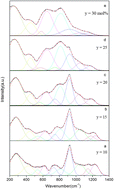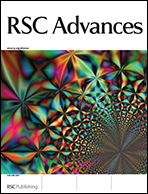An NMR and Raman spectroscopy study of Li2O–SrO–Nb2O5–P2O5 glasses
Abstract
A new Li–Sr–Nb phosphate series of glasses, Li2O–SrO–Nb2O5–P2O5, containing 0–40 mol% Li2O and 10–30 mol% Nb2O5 was prepared, and their structural properties, thermal properties and aqueous durability were systematically investigated. With addition of 0–30 mol% Li2O, the Q2 dominates the glass network accompanied with a few Q1 and Q3 tetrahedral units. However, for 40 mol% Li2O addition, Li+ cations depolymerize the P–O–P bonds on Q3 sites, resulting in the decrease in the cross-linking density and strength of the structure. Nb2O5 in our glass systems not only acts as a modifier but also as a glass former. The addition of Nb2O5 in the vitreous (60 − y)P2O5–yNb2O5–20SrO–20Li2O system creates a stronger P–O–Nb bonding to substitute P–O–P and O–P–O bonds evidenced by the Raman spectra, and eventually (Nb–O–Nb)chain and (Nb–O–Nb)3D are dominant in the structure. Thus the Nb2O5 composition effect shows a systematic trend in the enhancement of the network structure. Moreover, the composition effect on the distribution of Qi tetrahedral units was studied by NMR analysis in conjunction with deconvoluted Raman results. The effects of Li2O and Nb2O5 composition on the glass transition temperature, glass dilatometric softening temperature and coefficient of thermal expansion were also investigated. Experimental results reveal that the glass transition temperature and aqueous durability are considerably increased with increasing Nb2O5 content, but decreased with increasing Li2O content. The coefficient of thermal expansion is found to increase with increasing Li2O content. Lower Nb2O5 content, i.e., higher P2O5 content, in the Li–Sr–Nb phosphate serial glasses results in higher coefficient of thermal expansion, but the glasses still exhibit great structure stability. The aqueous durability is determined from the dissolution rate, which is strongly dependent on the Nb2O5 composition. The lowest dissolution rate is about 5 × 10−9 g cm−1 min−1, ensuring that the 30P2O5–30Nb2O5–(40 − x)SrO–xLi2O vitreous system demonstrates excellent aqueous durability.


 Please wait while we load your content...
Please wait while we load your content...